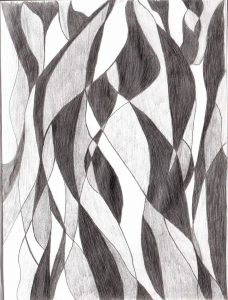When I think of disability I think of a period in my life. A time when I considered myself to be disabled. In a previous blog of mine I talk about this period; the period I spent in a wheelchair with a broken leg. In that blog, I describe it as being a “bird in a cage” and showcased an autobiographical depiction of that feeling in the form of a sketch (Dha). What caused me to feel like a “bird in a cage” at the time was the people surrounding me trying to help and support me (Dha). However, what they were doing was over accommodating me. What I mean by over accommodating is that the people around me would help me even when I could do something myself (Dha). Things that I could still do like reach for a bottle of water or pick up a pencil from the ground was done by others (Dha). This over accommodation was a cage being placed around me because I could still do certain things but blocked and hindered from being able to by the cage. This feeling of being a “bird in a cage” and the idea of disability is what I would like to expand on in this blog and to begin to think of them in new ways (Dha).
During my period of disability, I always thought about this feeling of being a “bird in a cage” due to others but never noticed that it caused me to feel further disabled (Dha). I was already disabled through my broken leg, through being in a wheelchair, through having to use the elevator, through needing help to go to the bathroom, through not being able to take a proper shower, and through many other changes, I had to face. I was disabled through these necessary things I needed and could no longer do, but added to the list was not being allowed to reach for a water bottle or pick up a pencil. Over-accommodation by others took the few things I could still do from me. Over-accommodation took the things I was able to do and turned it into things I was dis-abled to do. Increasing my disability, which should have reached its maximum point, by the continuous accommodation by others.
One over accommodation that I disliked the most was when a person would grab the back of my wheelchair and guide me through hallways and turns. I preferred it when people did not try to help me; I liked it when people simply watched and waited for something I could not handle to happened and then jump in. Ryan Knighton, in his memoir Cockeyed, talks about his experience with blindness (Knighton). Ryan Knighton also identifies the people he likes when passing by them on the street, in particular, he likes a group who he calls “jiggers” (Knighton). The “jiggers” are a group of people who react the same way when Knighton walks toward them with his cane in hand; they at first walk toward each other but then the “jiggers” wait until the last second to move out of Knighton’s way (Knighton).
Knighton also thinks of his cane as instant camouflage because it is easily retractable and even easier to hide in his pocket (Knighton). Camouflage in terms of hiding his disability from others around him because he wants to avoid the stigma of being seen as disabled. Unfortunately for me, I could not easily hide my wheelchair, my splint, or my ensuing limp.
What is important to understand is that my feeling of further disability and Knighton’s need to hide his disability with instant camouflage was caused by others. Caused by people who believed they were truly helping and doing the right thing by helping me. However, that help, that assistance, that accommodation, that aid, that charity, that volunteering, that helping yourself feel better, does not make me feel better; it makes me feel worse about my disability. Therefore, disability can not only be the cause of physical injury but by the accommodation of others. As Albert Einstein once said:
“If you judge a fish by its ability to climb a tree, it will live its whole life believing that its stupid” (Baskerville).
And if you continue to accommodate those who are disabled, it will make them feel further disabled. I never thought about this side of disability but it is important to look from these different perspectives because it allows us the better understand disability. For me, in particular, it helped me to better understand my feelings and how others changed how I felt about my disability.
Works Cited
Baskerville, Peter. “What Did Albert Einstein Mean When He Said: “Everybody Is A Genius. But If You Judge A Fish By Its Ability To Climb A Tree, It Will Live Its Whole Life Believing That It Is Stupid.” Quora, 2017, https://www.quora.com/What-did-Albert-Einstein-mean-when-he-said-Everybody-is-a-genius-But-if-you-judge-a-fish-by-its-ability-to-climb-a-tree-it-will-live-its-whole-life-believing-that-it-is-stupid. Accessed 7 Apr. 2017.
Dha, Gurneet. “A Bird in a Cage: How I Felt About My Broken Leg.” just a UBC blog, 20 Nov. 2017, www.blogs.ubc.ca/gurneetdha/. Accessed 7 Apr. 2017.
Knighton, Ryan. Cockeyed: A Memoir. New York: Public Affairs, 2006. Print.
